What is Urdhva Mukha Svanasana / Upward Facing Dog?
Urdhva Mukha Shvanasana is a back-bending asana in Yoga. The name of the pose is from the Sanskrit words Urdhva meaning “upwards” Mukha meaning “face”; and Shvana meaning “dog”. It is an important part of the Surya Namaskar series. This powerful backbend opens your heart and lifts your head, while improving your posture which are all physical movements that can combat feelings of depression and fatigue.
From Sanskrit to English:
Sanskrit pronunciation: Urdhva Mukha Svanasana (OORD-vah MOO-kah shvan-AHS-anna)
Meaning: urdhva = upward; mukha = facing; svana = dog
Many yoga asanas (poses) are named after animals and this pose is no exception. Indeed, it literally translates to Upward Facing Dog as it recalls how dogs usually stretch upward. First introduced in the mid-20th century by “the father of modern yoga”, Sri Tirumalai Krishnamacharya, Urdhva Mukha Svanasana belongs to the Surya Namaskar (Sun Salutation) and is also commonly referred to as Upward Dog or simply Up Dog.
If you are thinking about Yoga Teacher Training Course in India, click here.
Benefits of the Urdhva Mukha Svanasana pose
+ Stretches the back, abdomen, lungs and shoulders
+ Strengthens the back, shoulders, arms and wrists
+ Stimulates the organs in the abdominal cavity
+ Improves posture and alignment
+ Firms the buttocks
+ Relieves lower back ache, sciatica and asthma
+ Relieves mild depression and fatigue
Yoga for every BODY
Upward-Facing Dog provides a deep stretch in the upper body and – when done correctly – it can benefit the entire body. That said, it requires quite a lot of strength in the wrists and shoulders as well as flexibility in the back, neck, and ankles. Instead of seeking a deeper backbend prematurely, it is better to take it slowly and use the modifications (which are as beneficial) to prevent injuries.
Standard Urdhva Mukha Svanasana
1. Lie face-down on your mat with your legs extended a few centimeters apart, your toes pointing back.
2. Flatten your palms next to your lower ribs, your fingers pointing to the top of your mat.
3. Engage your mula bandha (root lock) and uddiyana bandha (abdominal lock), hug your elbows close to your ribcage, press into your hands and start straightening your arms while raising your sternum. Your shoulders should be directly above your wrists.
4. Actively draw your shoulders close to one another and away from the ears. Open your chest and send your heart towards the sky. Roll your upper arms slightly outward.
5. Press into the top of your feet (do not tuck your toes) and engage your legs to lift your knees off the mat. Turn them slightly inward.
6. If your neck allows, gaze towards the third eye. Otherwise, look forward.
From Chaturanga Dandasana:
1. Keeping your elbows hugged alongside your torso, press into your palms, engage your mula bandha and uddiyana bandha, and draw your body forward rolling over your toes.
2. Once your shoulders align directly above your wrists, straighten your arms and turn your upper arms slightly outward, so that each elbow crease faces forward.
3. Press firmly through the tops of your feet and engage your leg muscles to maintain your thighs lifted off the mat. Roll your thighs slightly inward.
4. Broaden your shoulder blades, send your shoulders away from the ears, open your chest and lift your heart.
5. If your neck allows, gaze towards the third eye. . Otherwise, look forward.
Modification 1: Supporting the lower ribs
This modification is meant to help you build a solid foundation for Urdhva Mukha Svanasana. It will give you a taste of the back bend happening in the pose and enable you to work on strengthening the back and arms, to eventually lift your body off the floor.
A
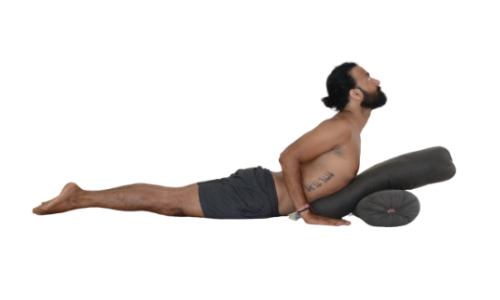
1. Grab two bolsters and arrange them so that they are perpendicular to each other; the lower one parallel to the shorter side of the mat and the upper one parallel to the longer side of the mat.
2. Lie face down, placing your lower ribs onto the bolster, your hands underneath your shoulders, and your elbows hugged to your ribcage.
3. Press into the top of your feet to engage your legs, and roll your thighs slightly inward.
4. Press into your palms, lift your sternum, draw your shoulders away from the ears and open your chest.
5. If your neck allows, look towards the third eye.
B
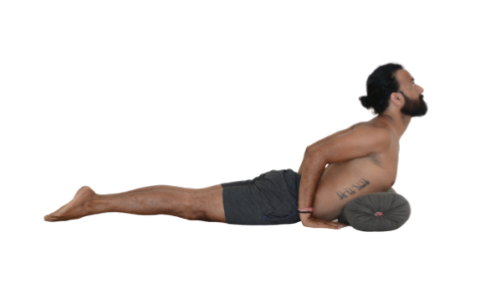
1. You can increase the challenge by removing the top bolster, drawing your body closer to the bolster so it can support your lower ribs.
2. Follow the instructions for version A but instead of placing your hands beneath your shoulders, place them right below the bolster, close to your lower ribs.
Modification 2: Baby Cobra Pose
Another excellent preparation for Upward Facing Dog is Ardha Bhujangasana (Baby Cobra Pose), given that it offers similar benefits yet is a milder back bend and requires less general strength. Indeed, while in Upward Facing Dog the entire body is above the floor, in Lower Cobra Pose the lower body still touches the floor and the elbows remain bent.
C
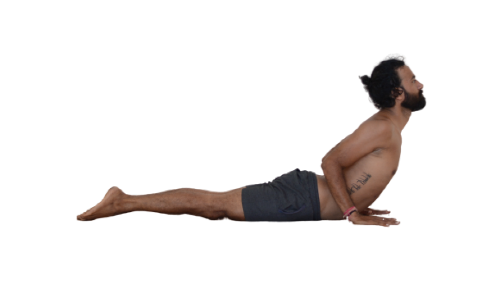
1. Lie face down, toes pointing back, palms besides your lower ribs (or beneath your shoulders for less intensity) and elbows hugged to the ribcage.
2. Press into your toes, engage your legs, and roll your thighs slightly inward.
3. Press into your hands and lift your torso. Your lower body shouldn’t lift off the floor
4. Actively draw your shoulder blades close to one another, send them away from the ears, open your chest and lift your heart.
5. If your neck allows, gaze towards the third eye. Otherwise, look forward.
Modification 3: Using a Chair
Using a chair significantly relieves the weight that your upper body is meant to support in Urdhva Mukha Svanasana. It will allow you to understand what the pose is meant to feel like, enabling your body to memorize the expected shape and correct alignment.
D
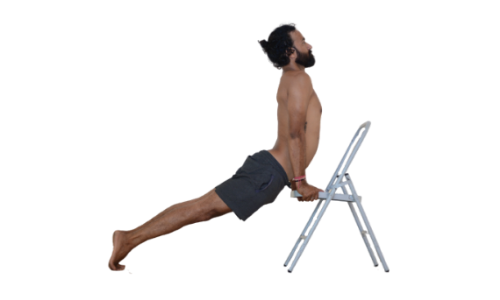
E
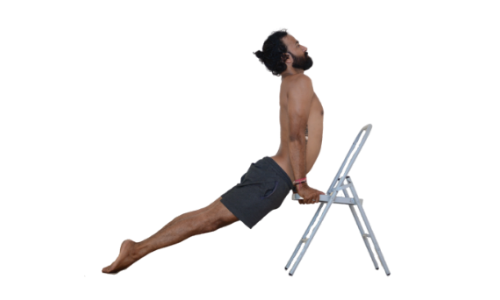
1. Place a chair at the top of your mat so it doesn’t slide, seat facing you.
2. Stand at a distance that allows you to grab the edges of the chair when you bend forward.
3. Once you get hold of the chair, make sure your arms are extended. Then, take a few steps back, come onto your toes and send your hips towards the edge of the seat. Lift your heart, send your shoulders away from the ears, and look forward (see picture D).
4. A deeper version of this is to keep drawing the body forward, rolling over your toes and sending your gaze towards the third eye (see picture E). If your feet, ankles or neck are tight, don’t hesitate to go back to the previous step (see picture D).
Modification 3: Using a blocks
This idea here is similar to Modification 3, except that it uses blocks instead of a chair, and therefore requires more strength to lift the body off the floor.
F
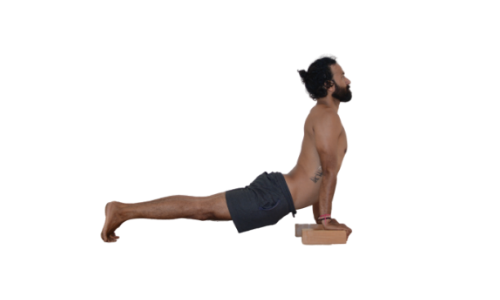
G
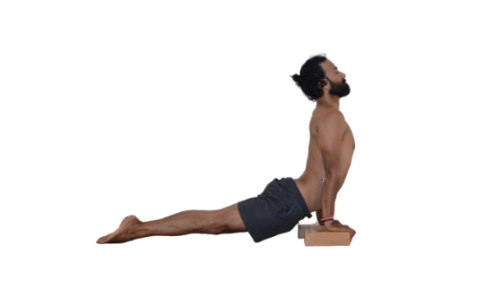
1. Place two blocks onto their lowest height, long side parallel to the longer side of your mat, shoulder-distance apart.
2. Get into Adho Mukha Svanasana supporting your hands with the blocks.
3. Keeping the arms straight, your mula bandha and uddiyana bandha engaged, come onto your toes and lower your hips towards the edge of the blocks while lifting your heart. Send your shoulders away from the ears and look forward (see picture F).
4. A deeper version of this is to keep drawing the body forward, rolling over your toes, and sending your gaze towards the third eye (see picture G). if at any point this feels too much, you can always go back to the previous step (see picture G).
Interested in becoming a yoga teacher?
Newsletter
Upcoming events and latest blogs